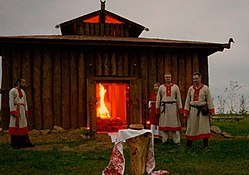Greece

- Temple of Alexander and the Earth (Ναός του Αλεξάνδρου και της Γης), in Mesaio, Central Macedonia [5]
- Temple of the Hellenic Gods (Ελλήνων Ναός), in Oraiokastro, Central Macedonia. [5]
- Temple of Zeus, Dionysus and Pan (Ναός του Δία, του Διόνυσου και του Πάνα), in Kalliani, Peloponnese. [6]








